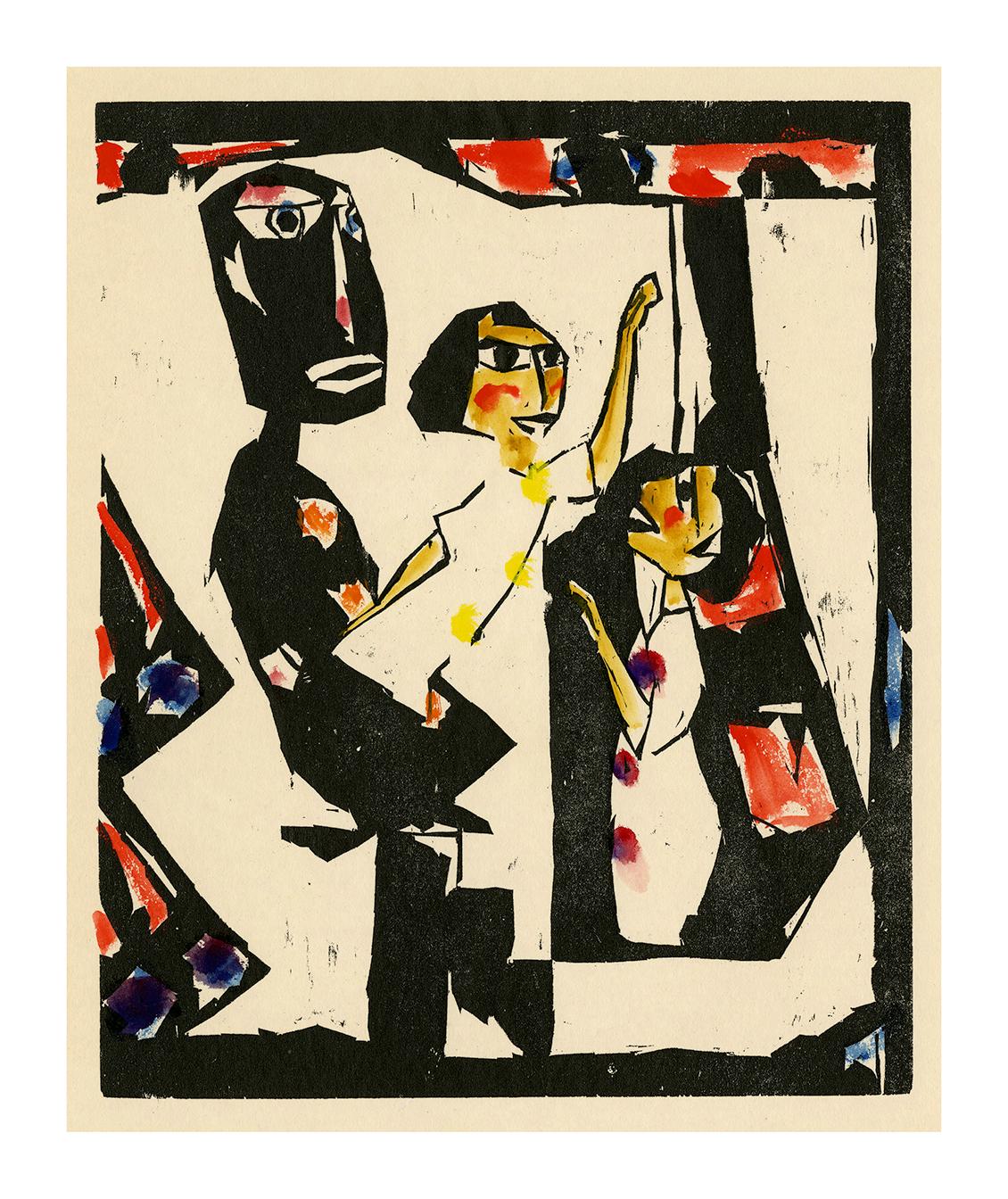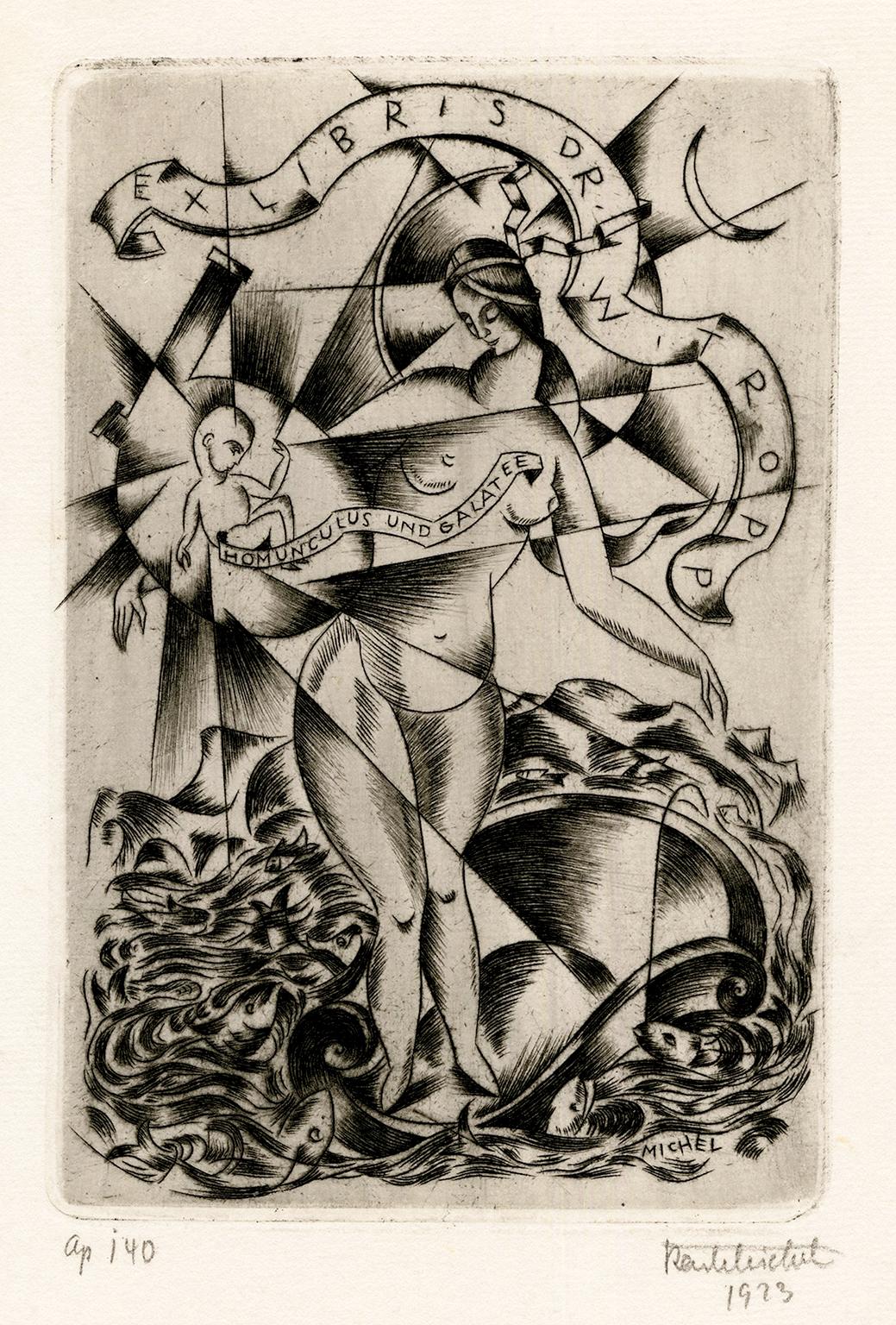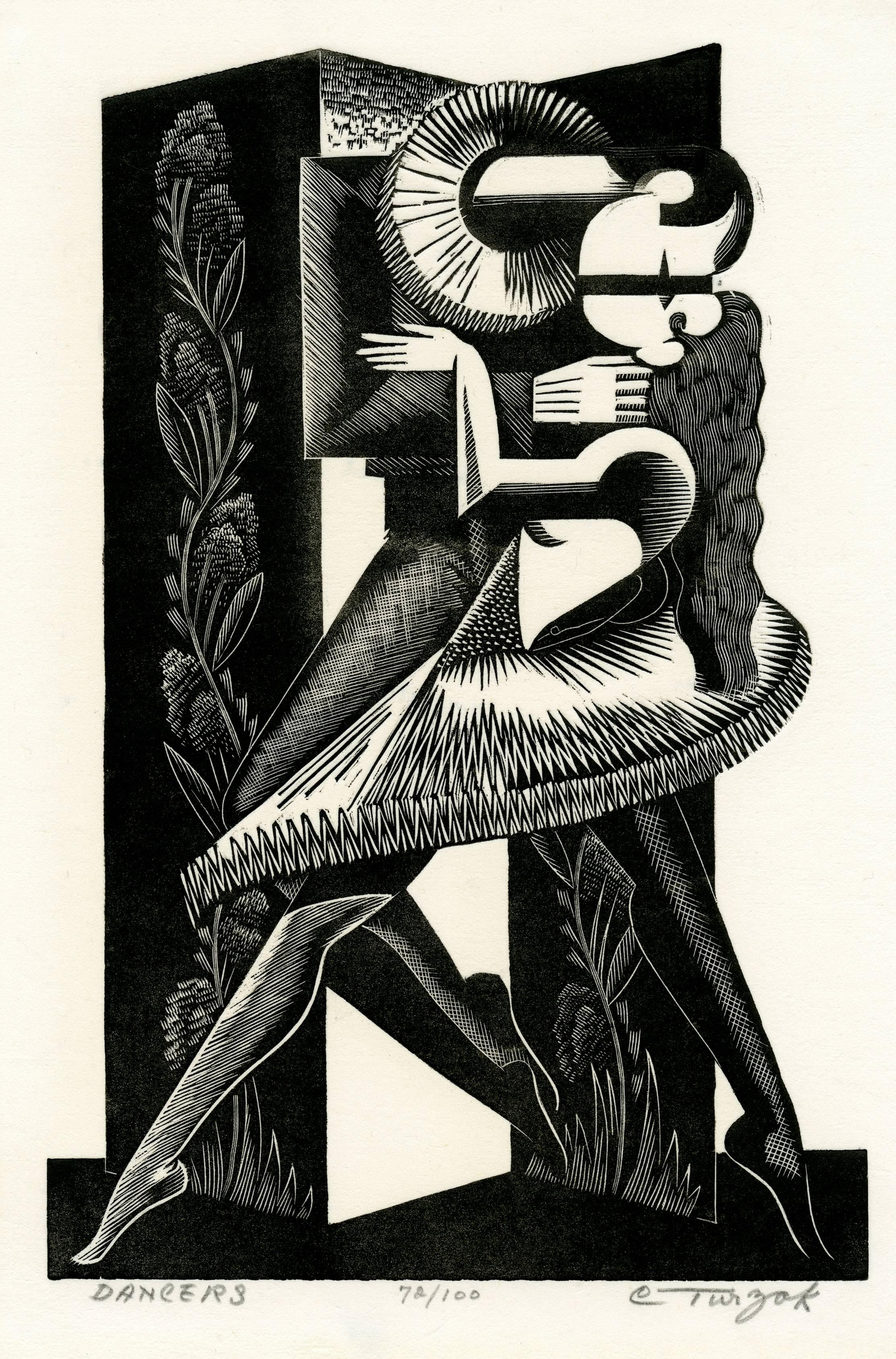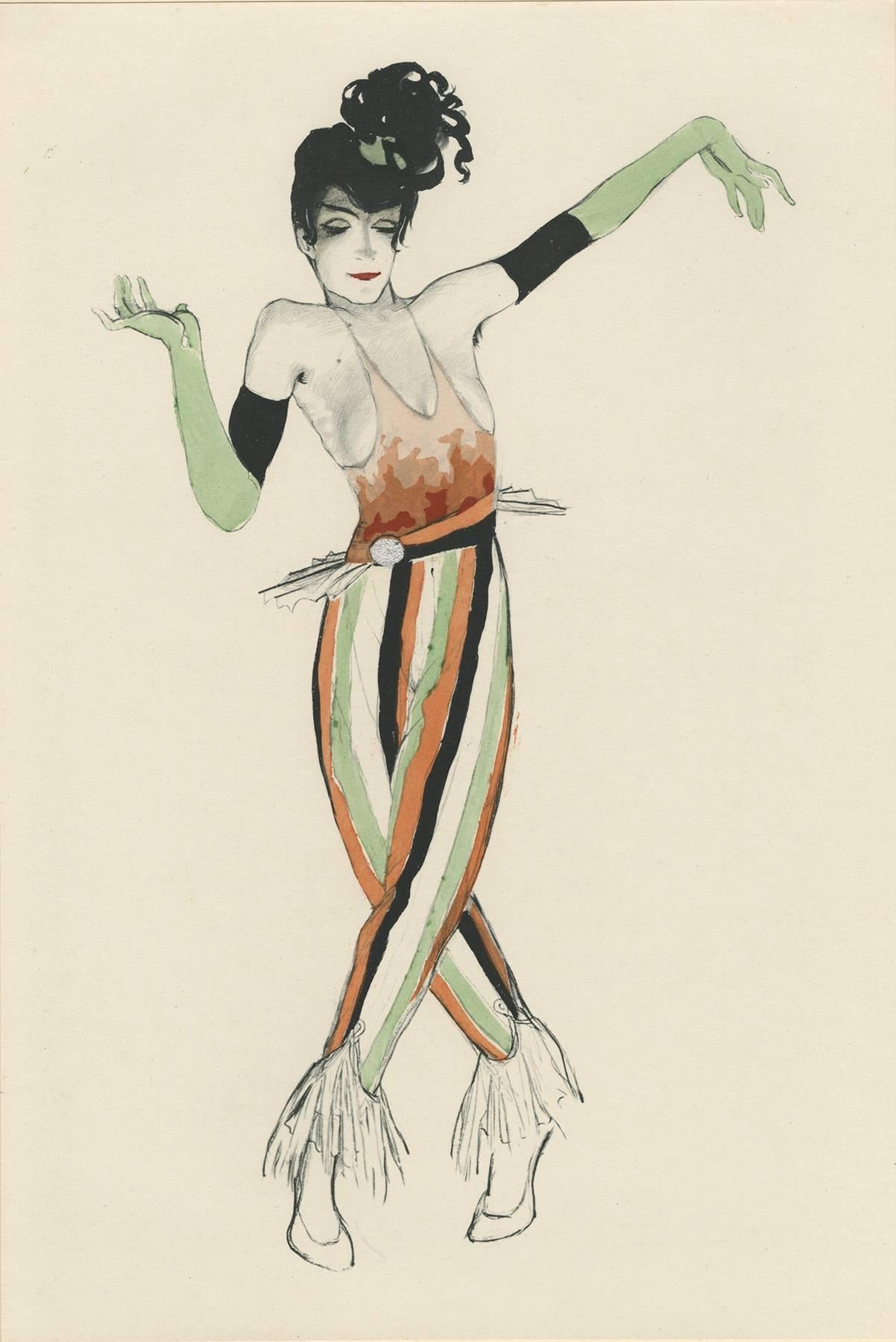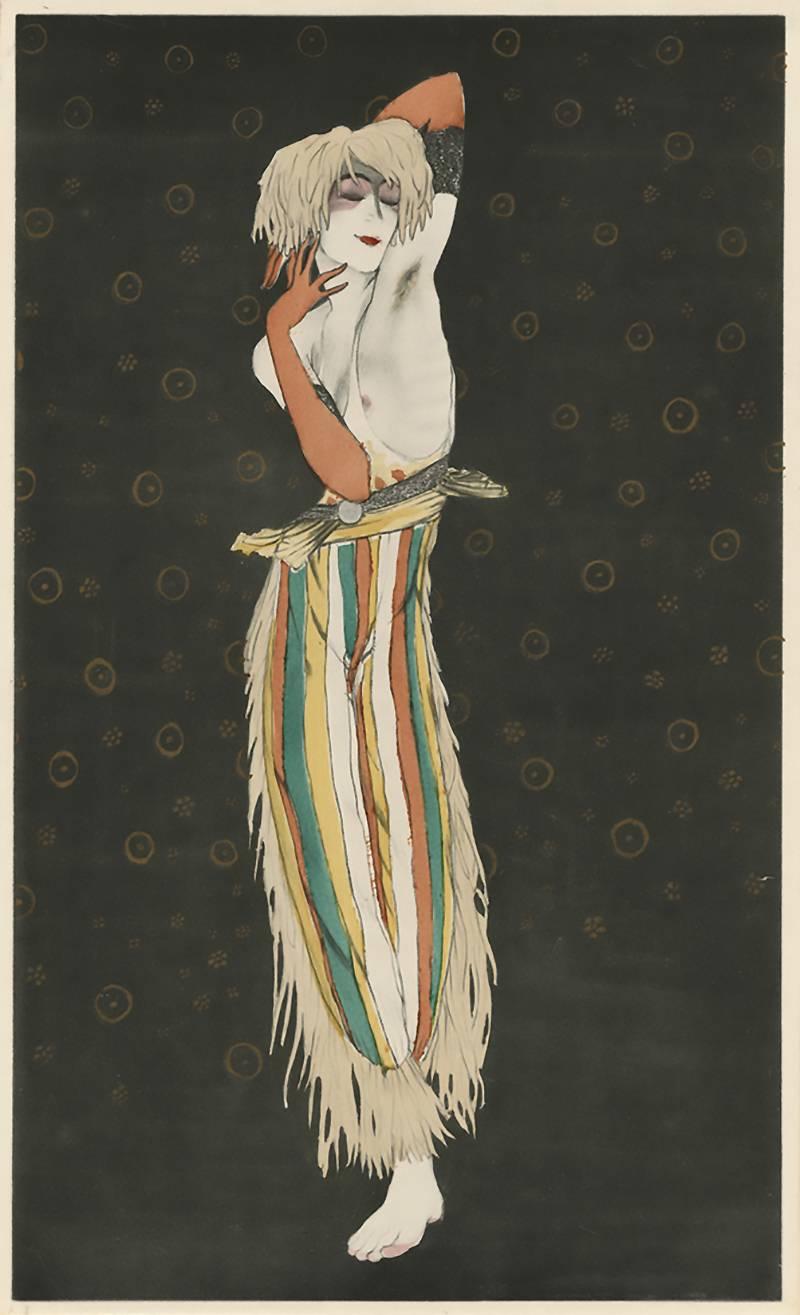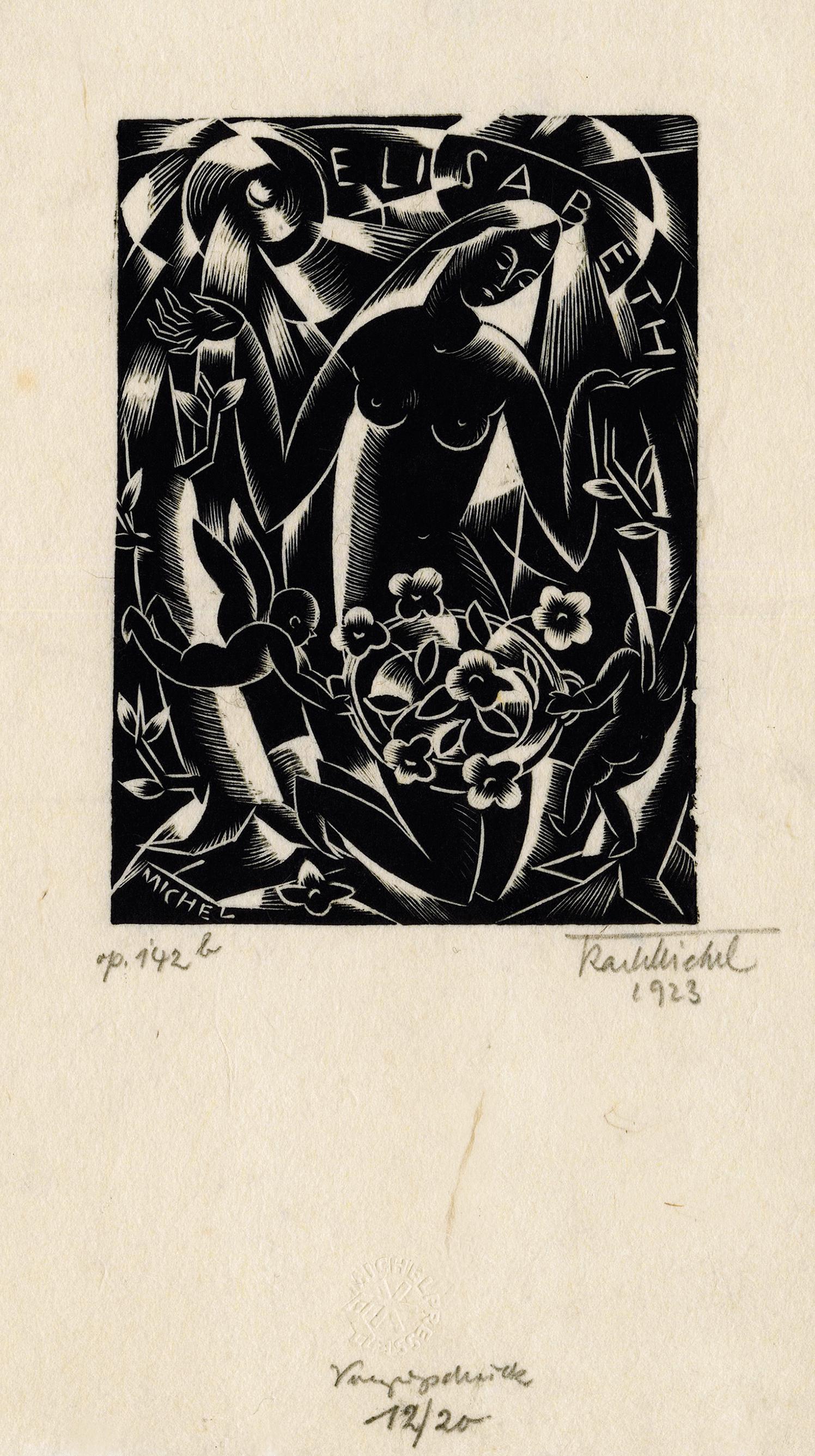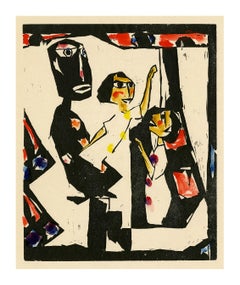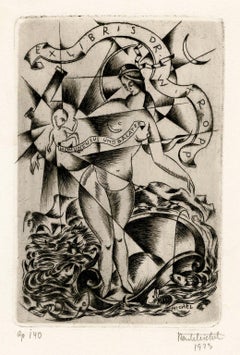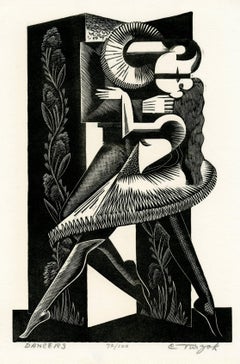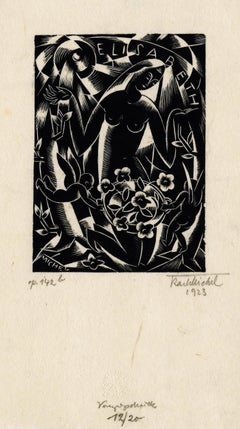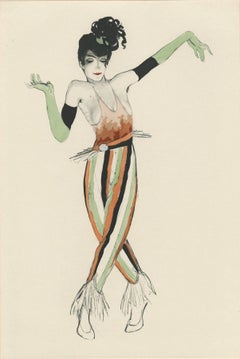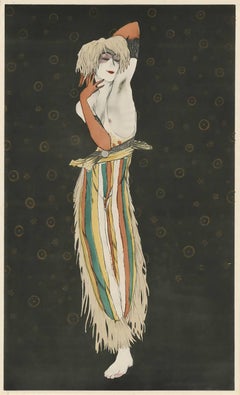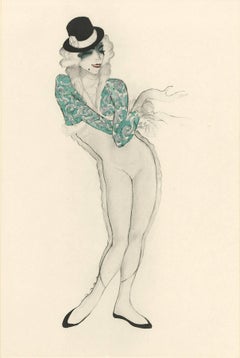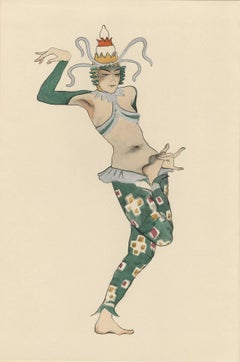Items Similar to 'Varietesoubrette, Schwalbennest' also Dancer — 1920s German Expressionism
Want more images or videos?
Request additional images or videos from the seller
1 of 3
Martel Schwichtenberg'Varietesoubrette, Schwalbennest' also Dancer — 1920s German Expressionism1922
1922
$440
$55020% Off
£342.85
£428.5620% Off
€388.95
€486.1820% Off
CA$632.38
CA$790.4720% Off
A$696.31
A$870.3920% Off
CHF 361.07
CHF 451.3320% Off
MX$8,246.23
MX$10,307.7820% Off
NOK 4,583.52
NOK 5,729.4020% Off
SEK 4,283.82
SEK 5,354.7720% Off
DKK 2,904.98
DKK 3,631.2220% Off
About the Item
Martel Schwichtenberg (1896-1945), 'Varietésoubrette, Schwalbennest (Variety Soubrette, Swallow’s Nest), drypoint, 1922. Signed in pencil. A fine, richly-inked impression; the full sheet of cream wove paper, with wide margins (3 3/4 to 5 1/4 inches), in excellent condition. Image size 7 3/16 x 4 5/16 inches; sheet size 16 3/8 x 12 1/8 inches. Archivally matted to museum standards, unframed.
Published in Die Schaffenden III: Shön VII, 72712-9, with the Die Schaffenden blind stamp in the bottom left sheet corner.
After World War I, illustrated books and printed portfolios became increasingly popular with collectors due mainly to several German publishers and art dealers, who often worked directly with the artists and commissioned specific works. The art critic and collector Paul Westheim was the editor of the progressive art journal Das Kunstblatt (The Art Sheet) and also launched the portfolio series Die Schaffenden (The Creators), published between 1918 and 1932, which featured original prints by progressive artists such as Erich Heckel and Max Kaus. By the 1920s, books and the distinctly German phenomenon of the print portfolio had become the central means of presenting modernist innovations, from Dada to Bauhaus experimentations with type fonts and graphic design.
An impression of this work is in the permanent collection of the Gemeente Museum, The Hague.
About the Seller
5.0
Recognized Seller
These prestigious sellers are industry leaders and represent the highest echelon for item quality and design.
Platinum Seller
Premium sellers with a 4.7+ rating and 24-hour response times
Established in 1995
1stDibs seller since 2016
331 sales on 1stDibs
Typical response time: 1 hour
Associations
International Fine Print Dealers Association
- ShippingRetrieving quote...Shipping from: Myrtle Beach, SC
- Return Policy
More From This Seller
View All'Theater' — 1920s German Expressionism
Located in Myrtle Beach, SC
A German Expressionist woodcut, with original hand-coloring in watercolor, depicting a parent and child watching a theatrical production; ...
Category
1920s Expressionist Figurative Prints
Materials
Woodcut
'Ex Libris Dr. Witropp' — German Expressionism
By Karl Michel
Located in Myrtle Beach, SC
Karl Michel, 'Ex Libris Dr. Witropp - Homunculus und Galatee', etching, 1923, edition not stated. Signed, dated, and numbered 'Op. 140' (the artist's inventory number) in pencil. Si...
Category
1920s Expressionist Figurative Prints
Materials
Etching
'Dancers' — 1930s American Modernism
By Charles Turzak
Located in Myrtle Beach, SC
Charles Turzak, 'Dancers', 1939, wood engraving, edition 100. Signed, titled, and numbered 72/100 in pencil. A fine, richly-inked impression, on off-white Japan paper, with full marg...
Category
Mid-20th Century Art Deco Figurative Prints
Materials
Woodcut
'Elisabeth' — German Expressionism
By Karl Michel
Located in Myrtle Beach, SC
Karl Michel, 'Elisabeth', woodcut, edition 20, 1923. Signed, dated, and numbered 'op.142b' and '12/20' in pencil. Signed in the block, lower left. Annotated 'Vorgesdruck' [artist’s proof] in pencil.
A fine impression, on heavy fibrous Japan paper, with full margins (1 3/16 to 3 1/2 inches),
in good condition. Printed by the artist, With the artist’s blindstamp in the bottom center margin. Scarce. Matted to museum standards, unframed.
Image size 4 15/16 x 6 inches (131 x 152 mm); sheet size 10 x 6 inches (254 x 152 mm).
ABOUT THE ARTIST
Karl Michel (1889-1984) was a noted graphic designer and expressionist printmaker during Germany's pre-Nazi Weimar Republic (1919-1933). Michel’s work was the subject of a feature article in the influential German graphic design magazine Das Plakat (The Poster) in 1920. An anti-war advocate, Michel created a suite of 12 wood engravings depicting his impressions of the humanitarian toll of WWII entitled ‘Humanitas’ (Humanity). The German publishing house Greifenverlag published the series in a reduced folio of unsigned prints.
Michel’s graphic work is held in the permanent collections of the Auckland War Memorial Museum (New Zealand), Frederikshavn Kunstmuseum & Exlibrissamling (Denmark), Museum of Applied Arts (Budapest), The Robert Gore Rifkind Center for German Expressionist Studies at the Los Angeles County Museum of Art, and the German Expressionism...
Category
1920s Expressionist Figurative Prints
Materials
Woodcut
'Le Tir Forain' (Fairground Shooting) — 1920s French Cubism
By Jean-Emile Laboureur
Located in Myrtle Beach, SC
Le Tir Forain, engraving, edition 108, 1920-21, Sylvain Laboureur 191. Signed and numbered '19/85 ép' in pencil. Initialed 'L' and dated 1920 in the matrix,...
Category
1920s Cubist Figurative Prints
Materials
Engraving
'Ex Libris Verein' — 1920s German Expressionism
By Karl Michel
Located in Myrtle Beach, SC
Karl Michel, 'Ex Libris Verein' (New Year's Ex Libris Club Announcement), etching, 1924. Signed, dated, and numbered 'op. 167' in pencil. Signed and dated in...
Category
1920s Expressionist Figurative Prints
Materials
Etching
You May Also Like
Ballet und Pantomime "Scherzo II", plate #15.
By Walter Schnackenberg
Located in Palm Beach, FL
Walter Schnackenberg’s style changed several times during his long and successful career. Having studied in Munich, the artist traveled often to Paris where he fell under the spell o...
Category
1920s Art Deco Figurative Prints
Materials
Paper
Ballet und Pantomime "Scherzo I", plate #4.
By Walter Schnackenberg
Located in Palm Beach, FL
Walter Schnackenberg’s style changed several times during his long and successful career. Having studied in Munich, the artist traveled often to Paris where he fell under the spell of the Henri de Toulouse-Lautrec’s colorful and sensuous posters depicting theatrical and decadent subjects. Schnackenberg became a regular contributor of similar compositions to the German magazines Jugend and Simplicissimus before devoting himself to the design of stage scenery and costumes. In the artist’s theatrical work, his mastery of form, ornamentation, and Orientalism became increasingly evident. He excelled at combining fluid Art Nouveau outlines, with spiky Expressionist passages, and the postures and patterns of the mysterious East.
In his later years, Schnackenberg explored the unconscious, using surreal subject matter and paler colors that plainly portrayed dreams and visions, some imbued with political connotations. His drawings, illustrations, folio prints, and posters are highly sought today for their exceedingly imaginative qualities, enchanting subject matter, and arresting use of color.
SCHNACKENBERG BALLET UND PANTOMIME...
Category
1920s Art Deco Figurative Prints
Materials
Paper
Ballet und Pantomime "Walzer", plate #21.
By Walter Schnackenberg
Located in Palm Beach, FL
Walter Schnackenberg’s style changed several times during his long and successful career. Having studied in Munich, the artist traveled often to Paris where he fell under the spell of the Henri de Toulouse-Lautrec’s colorful and sensuous posters depicting theatrical and decadent subjects. Schnackenberg became a regular contributor of similar compositions to the German magazines Jugend and Simplicissimus before devoting himself to the design of stage scenery and costumes. In the artist’s theatrical work, his mastery of form, ornamentation, and Orientalism became increasingly evident. He excelled at combining fluid Art Nouveau outlines, with spiky Expressionist passages, and the postures and patterns of the mysterious East.
In his later years, Schnackenberg explored the unconscious, using surreal subject matter and paler colors that plainly portrayed dreams and visions, some imbued with political connotations. His drawings, illustrations, folio prints, and posters are highly sought today for their exceedingly imaginative qualities, enchanting subject matter, and arresting use of color.
SCHNACKENBERG BALLET UND PANTOMIME...
Category
1920s Art Deco Figurative Prints
Materials
Paper
Ballet und Pantomime "Bingha", plate #8.
By Walter Schnackenberg
Located in Palm Beach, FL
Walter Schnackenberg’s style changed several times during his long and successful career. Having studied in Munich, the artist traveled often to Paris where he fell under the spell of the Henri de Toulouse-Lautrec’s colorful and sensuous posters depicting theatrical and decadent subjects. Schnackenberg became a regular contributor of similar compositions to the German magazines Jugend and Simplicissimus before devoting himself to the design of stage scenery and costumes. In the artist’s theatrical work, his mastery of form, ornamentation, and Orientalism became increasingly evident. He excelled at combining fluid Art Nouveau outlines, with spiky Expressionist passages, and the postures and patterns of the mysterious East.
In his later years, Schnackenberg explored the unconscious, using surreal subject matter and paler colors that plainly portrayed dreams and visions, some imbued with political connotations. His drawings, illustrations, folio prints, and posters are highly sought today for their exceedingly imaginative qualities, enchanting subject matter, and arresting use of color.
SCHNACKENBERG BALLET UND PANTOMIME...
Category
1920s Art Deco Figurative Prints
Materials
Paper
Ballet und Pantomime "Tschaikiun I", print #3.
By Walter Schnackenberg
Located in Palm Beach, FL
Walter Schnackenberg’s style changed several times during his long and successful career. Having studied in Munich, the artist traveled often to Paris where he fell under the spell o...
Category
1920s Art Deco Figurative Prints
Materials
Paper
Ballet und Pantomime "Groteske", plate #22.
By Walter Schnackenberg
Located in Palm Beach, FL
Walter Schnackenberg’s style changed several times during his long and successful career. Having studied in Munich, the artist traveled often to Paris where he fell under the spell of the Henri de Toulouse-Lautrec’s colorful and sensuous posters depicting theatrical and decadent subjects. Schnackenberg became a regular contributor of similar compositions to the German magazines Jugend and Simplicissimus before devoting himself to the design of stage scenery and costumes. In the artist’s theatrical work, his mastery of form, ornamentation, and Orientalism became increasingly evident. He excelled at combining fluid Art Nouveau outlines, with spiky Expressionist passages, and the postures and patterns of the mysterious East.
In his later years, Schnackenberg explored the unconscious, using surreal subject matter and paler colors that plainly portrayed dreams and visions, some imbued with political connotations. His drawings, illustrations, folio prints, and posters are highly sought today for their exceedingly imaginative qualities, enchanting subject matter, and arresting use of color.
SCHNACKENBERG BALLET UND PANTOMIME...
Category
1920s Art Deco Figurative Prints
Materials
Paper
More Ways To Browse
Dior Stamp
German Bauhaus Prints
J Alphege Brewer
J Didier
Jack Chandler
James A Pritchard
Jane Rogers
Japanese Warrior Woodblock Print
Japanese Woodblock Print Kuniyoshi
Japanese Woodblock Tree
Jean Jacques Sempe
Jean Michel Folon On Sale
Jennifer Packer
Jim Dine 8 Hearts
Jim Dine Flowers
Jim Vest
Jockstrap Vintage
John Lawrence Doyle
